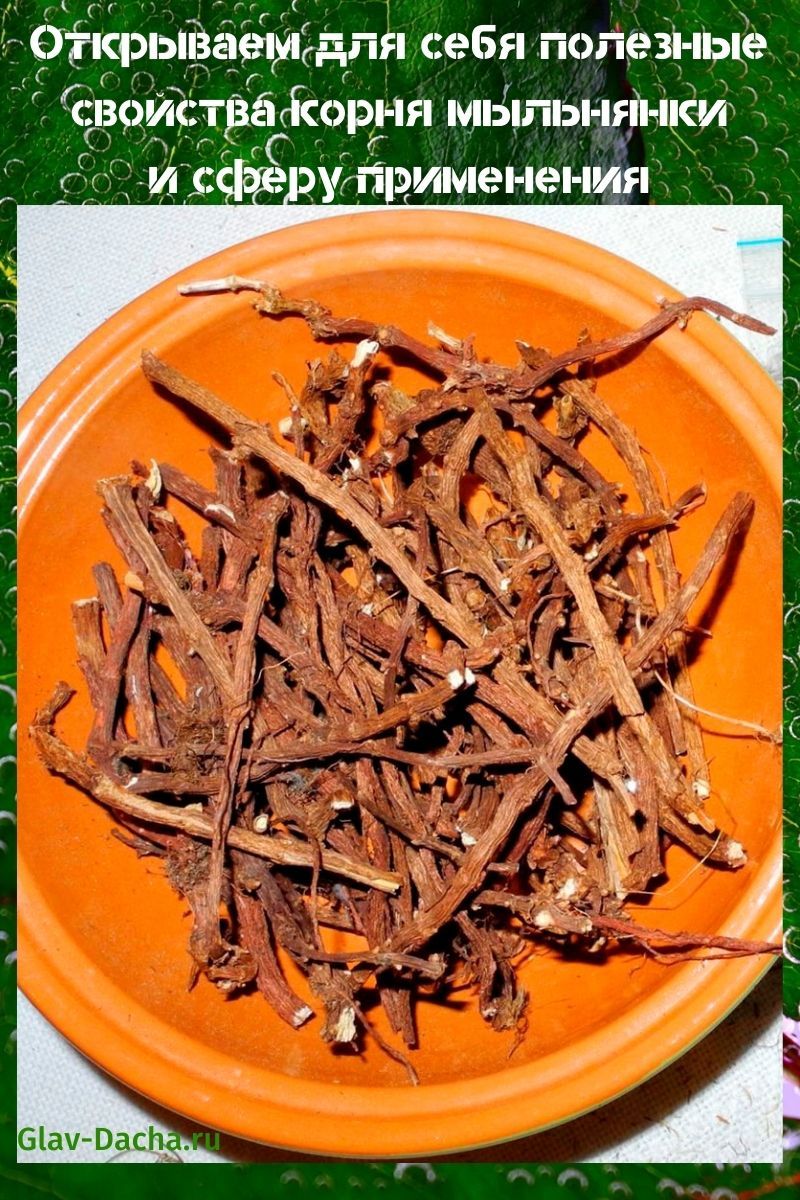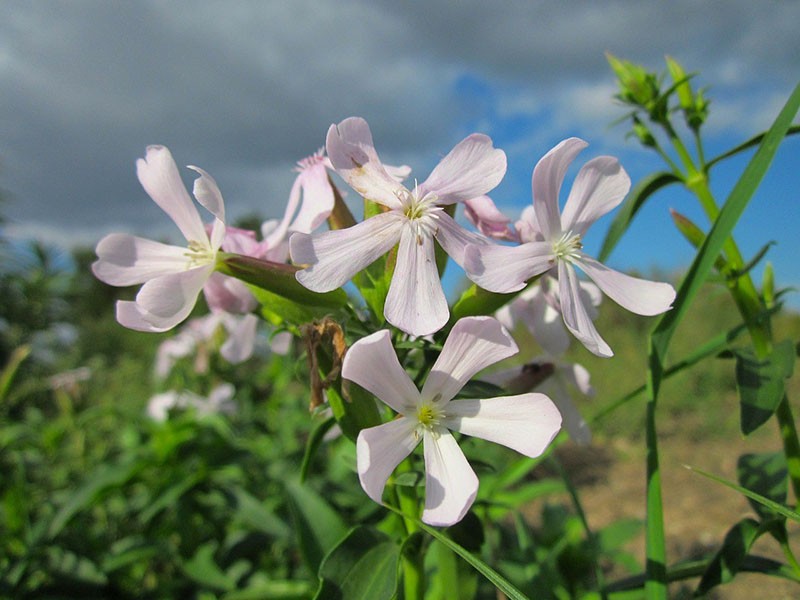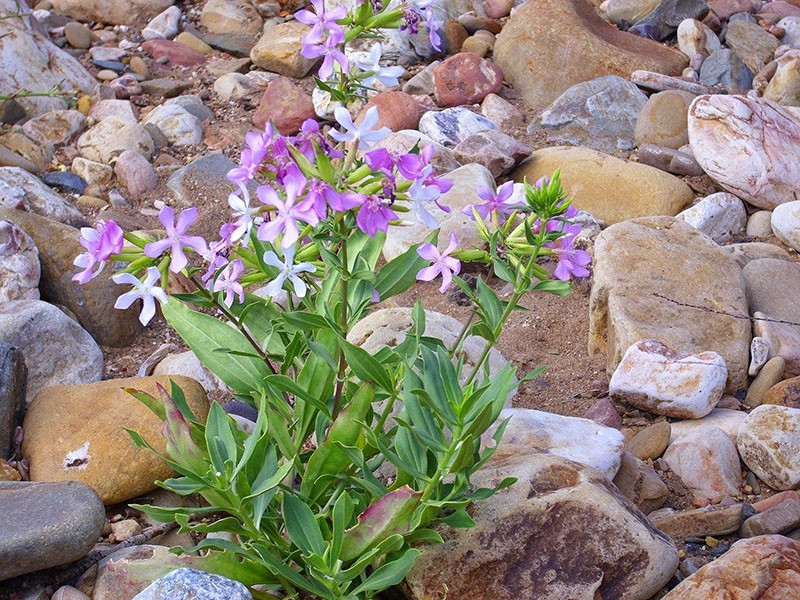Discovering the beneficial properties of soapwort root and its scope
 Because of the vanity of life, many people do not pay attention to the "jewels" that are under our feet. Among the huge number of medicinal plants, special delight is caused by the beneficial properties of soapwort root - a cute garden flower. Many centuries ago, curious healers paid attention to this plant. After rubbing the delicate buds in the hands, a fragrant foam appeared. She softened and cleansed the skin. Over time, they found similar properties in the underground part of the culture.
Because of the vanity of life, many people do not pay attention to the "jewels" that are under our feet. Among the huge number of medicinal plants, special delight is caused by the beneficial properties of soapwort root - a cute garden flower. Many centuries ago, curious healers paid attention to this plant. After rubbing the delicate buds in the hands, a fragrant foam appeared. She softened and cleansed the skin. Over time, they found similar properties in the underground part of the culture.
In the 21st century, the components of soapwort are actively used in cooking, cosmetology, as well as in the production of household cleaning products. Representatives of traditional medicine use the beneficial properties of soapwort root to treat various ailments. What does a flower look like from the side? Where does it grow? What substances does it contain and where is it used specifically? Let's figure out what experts say about this.
Botanical features of a unique plant

It has a number of other names that ordinary people use:
- cleanliness;
- bubble worm;
- bean;
- lukushkino soap;
- white carnation;
- field violet;
- dog or Tatar soap.
 During the season, the medicinal herb soapwort grows up to 70 cm in height. The underground part consists of a branchy rhizome of a knotty character. Outside, it is painted brown, and inside it is yellow-white. Many erect stems emerge from it, which branch closer to the tops and are slightly pubescent.
During the season, the medicinal herb soapwort grows up to 70 cm in height. The underground part consists of a branchy rhizome of a knotty character. Outside, it is painted brown, and inside it is yellow-white. Many erect stems emerge from it, which branch closer to the tops and are slightly pubescent.
 Leaf plates of the culture are lanceolate with narrowed tips. There is a short petiole at the base. Fragrant buds are located on miniature pedicels up to 7 mm long. They are collected in loose paniculate inflorescences. The petals are white or pinkish. After pollination, instead of fragrant flowers, fruits are formed in the form of a box with one "nest". They contain many black seeds that ripen in early autumn. Flowering begins in early summer and lasts until around the end of August.
Leaf plates of the culture are lanceolate with narrowed tips. There is a short petiole at the base. Fragrant buds are located on miniature pedicels up to 7 mm long. They are collected in loose paniculate inflorescences. The petals are white or pinkish. After pollination, instead of fragrant flowers, fruits are formed in the form of a box with one "nest". They contain many black seeds that ripen in early autumn. Flowering begins in early summer and lasts until around the end of August.
 To get to know the plant better, consider where the medicinal soapwort grows in nature. The information will help to timely prepare valuable raw materials for the preparation of healing potions. The flower is found in Russia, Ukraine, Kazakhstan and Central Asia. It successfully takes root in the coastal zone of water bodies. The soapwort can be found on open forest edges, wastelands and even among thickets of ornamental shrubs.
To get to know the plant better, consider where the medicinal soapwort grows in nature. The information will help to timely prepare valuable raw materials for the preparation of healing potions. The flower is found in Russia, Ukraine, Kazakhstan and Central Asia. It successfully takes root in the coastal zone of water bodies. The soapwort can be found on open forest edges, wastelands and even among thickets of ornamental shrubs.
Rules for the collection and storage of raw materials
Traditional healers are serious about harvesting medicinal herbs. After all, their reputation and the health of patients depend on it.
The soapwort for medicinal purposes is used:
- inflorescences;
- sheet plates;
- root system.
 The ground part is collected at different times. The foliage is cut in the middle of summer. The buds are harvested during flowering. First, the components are cleaned of dust. Then they are laid out on a baking sheet and sent to the oven, preheated to 50 ° C. When the leaves and inflorescences are completely dry, they are put in glass jars. Store in the dark, dry and cool. Used for 12 months.
The ground part is collected at different times. The foliage is cut in the middle of summer. The buds are harvested during flowering. First, the components are cleaned of dust. Then they are laid out on a baking sheet and sent to the oven, preheated to 50 ° C. When the leaves and inflorescences are completely dry, they are put in glass jars. Store in the dark, dry and cool. Used for 12 months.
The rhizome is removed from the soil in late autumn, when the upper part of the plant is completely dry. The excavated elements are cleared of the remains of the earth. Rinse under running water. Cut into pieces. Spread out on paper and dry in the fresh air or in a well-ventilated room. The main condition is to stay away from direct sunlight. The finished roots are laid out in paper bags and stored in a cool dry place.
In urban conditions, raw materials are prepared using an electric dryer at a temperature of 50 ° C.
Unique combination of components
 Thanks to the painstaking research of biologists, the chemical composition of the culture has been discovered.
Thanks to the painstaking research of biologists, the chemical composition of the culture has been discovered.
It turned out that the soap grass plant contains a number of valuable components:
- vitamin C;
- B vitamins;
- pectins;
- mucus;
- organic acids;
- flavonoids;
- vitamin D;
- carotene;
- alkaloids;
- tannins;
- minerals (calcium, magnesium, zinc).
 Most of the compounds are concentrated in the rhizome of the culture. Therefore, it is more often used to prepare detergents and cosmetics. Healing medicines derived from original raw materials deserve special attention.
Most of the compounds are concentrated in the rhizome of the culture. Therefore, it is more often used to prepare detergents and cosmetics. Healing medicines derived from original raw materials deserve special attention.
Useful properties of soapwort root for the body
 The emergence of deadly viruses prompts people to look for new ways to protect themselves. Pharmacists produce powerful drugs. Fans of a healthy lifestyle are engaged in physical activity, drink a lot of water and eat only natural products.
The emergence of deadly viruses prompts people to look for new ways to protect themselves. Pharmacists produce powerful drugs. Fans of a healthy lifestyle are engaged in physical activity, drink a lot of water and eat only natural products.
Traditional healers adhere to ancient traditions. They actively use the beneficial properties of soapwort root to treat a number of colds:
- pneumonia;
- bronchitis;
- laryngitis;
- tracheitis;
- whooping cough;
- pharyngitis.
 Potions obtained from various parts of the plant stimulate the immune system to fight against pathogenic microorganisms. They cleanse the body of toxins. Helps stabilize metabolism. Phyto-drugs are used for severe joint pain.
Potions obtained from various parts of the plant stimulate the immune system to fight against pathogenic microorganisms. They cleanse the body of toxins. Helps stabilize metabolism. Phyto-drugs are used for severe joint pain.
 During colds, the tincture of the dried plant acts as a warming agent, causing profuse sweating. Homemade soap root decoction contains a large amount of pectin elements. Therefore, it is prescribed for people who have intestinal problems. All kinds of tinctures are used as an external "medicine".
During colds, the tincture of the dried plant acts as a warming agent, causing profuse sweating. Homemade soap root decoction contains a large amount of pectin elements. Therefore, it is prescribed for people who have intestinal problems. All kinds of tinctures are used as an external "medicine".
A decoction and tincture helps to get rid of such ailments:
- scabies;
- psoriasis;
- eczema;
- dermatitis;
- scrofula.
 If necessary, herbal "preparations" are prescribed as auxiliary components in the treatment of gout, rheumatism and polyarthritis. However, do not think that the plant is a panacea for all ills. The business is approached individually. The drug helps someone right away. Others have a long struggle to see a positive outcome. Let's not rush to conclusions.
If necessary, herbal "preparations" are prescribed as auxiliary components in the treatment of gout, rheumatism and polyarthritis. However, do not think that the plant is a panacea for all ills. The business is approached individually. The drug helps someone right away. Others have a long struggle to see a positive outcome. Let's not rush to conclusions.
Decoctions or tinctures of soap root are taken strictly according to the scheme determined by the specialist.
As you know, the culture contains an abundance of saponin. It is a foaming component. Thanks to this, our ancestors used raw materials for washing woolen and silk clothes. Connoisseurs of external beauty used soap root for hair when preparing a natural shampoo.
A similar detergent is made in our time:
- Crushed raw materials (1 tablespoon) are poured with boiling water (0.5 l).
- Cover and leave for 40 minutes.
- Then bring to a boil and simmer over moderate heat for 10 minutes.
- The finished shampoo is filtered. Store the detergent in the refrigerator.
It is advisable to add 1 tablespoon of freshly squeezed lemon juice to the product.
Serious contraindications
 A well-known proverb says: "We treat one organ and cripple the other." Unfortunately, this also applies to "preparations" obtained from plant materials.
A well-known proverb says: "We treat one organ and cripple the other." Unfortunately, this also applies to "preparations" obtained from plant materials.
As you know, soapwort contains poisonous substances, which, in case of an overdose, cause a number of symptoms:
- nausea;
- cough;
- vomiting;
- diarrhea;
- convulsions.
If this happens, you must immediately abandon the medicinal drug, call the attending physician or an ambulance. As a last resort, take activated charcoal or regular baking soda immediately. In addition, doctors do not recommend that pregnant and lactating women be treated with culture components. The "medicine" is not suitable for children under 8 years old, elderly people who have serious kidney or heart disease.
 There is a lot of controversy over whether or not the soap root extract is harmful to the body. It turns out that the substance is often used in the food industry. For example, it is included in the composition of dessert sweets and halva.
There is a lot of controversy over whether or not the soap root extract is harmful to the body. It turns out that the substance is often used in the food industry. For example, it is included in the composition of dessert sweets and halva.
Thus, the quality of the product is increased, which contains:
- vegetable fats;
- carbohydrates;
- proteins;
- alimentary fiber;
- vitamins;
- trace elements.
 It turns out that the extract of the soap root in halva cannot bring any serious harm to the body. Unless only for people suffering from diabetes, allergies or high acidity of the stomach. The product is wonderfully absorbed by the body and has a beneficial effect on the brain and cardiovascular system.
It turns out that the extract of the soap root in halva cannot bring any serious harm to the body. Unless only for people suffering from diabetes, allergies or high acidity of the stomach. The product is wonderfully absorbed by the body and has a beneficial effect on the brain and cardiovascular system.
Excessive consumption of sweets leads to metabolic disorders and addiction.
As you can see, the soap box has been in trend for several centuries. A unique set of elements helps to strengthen the body during epidemics. It helps to cope with joint pain and skin conditions. The raw materials are suitable for making sweets and detergents. Let's not pass by a modest plant - soapwort.